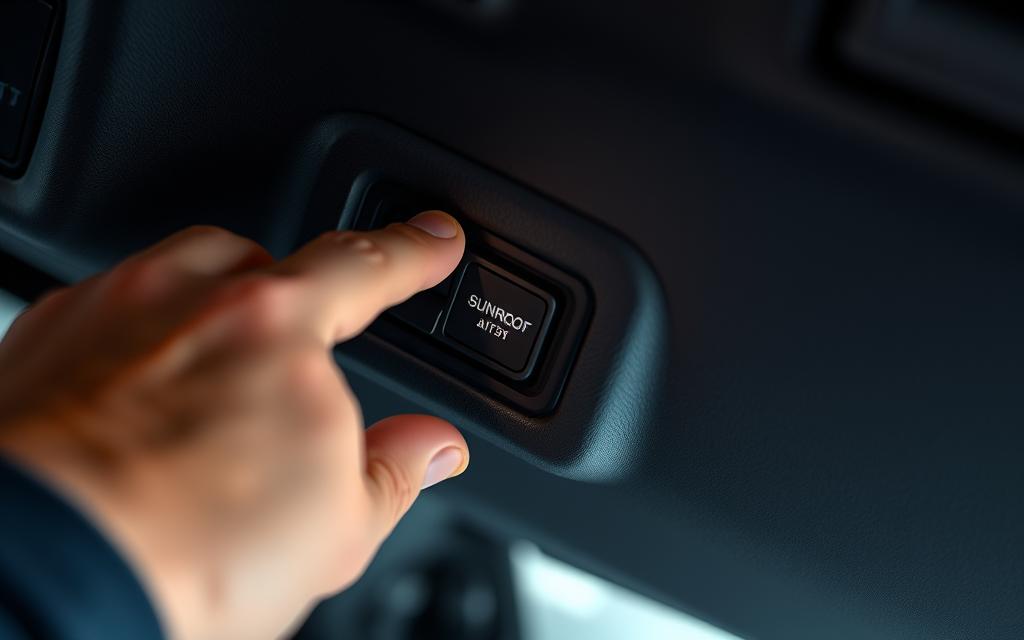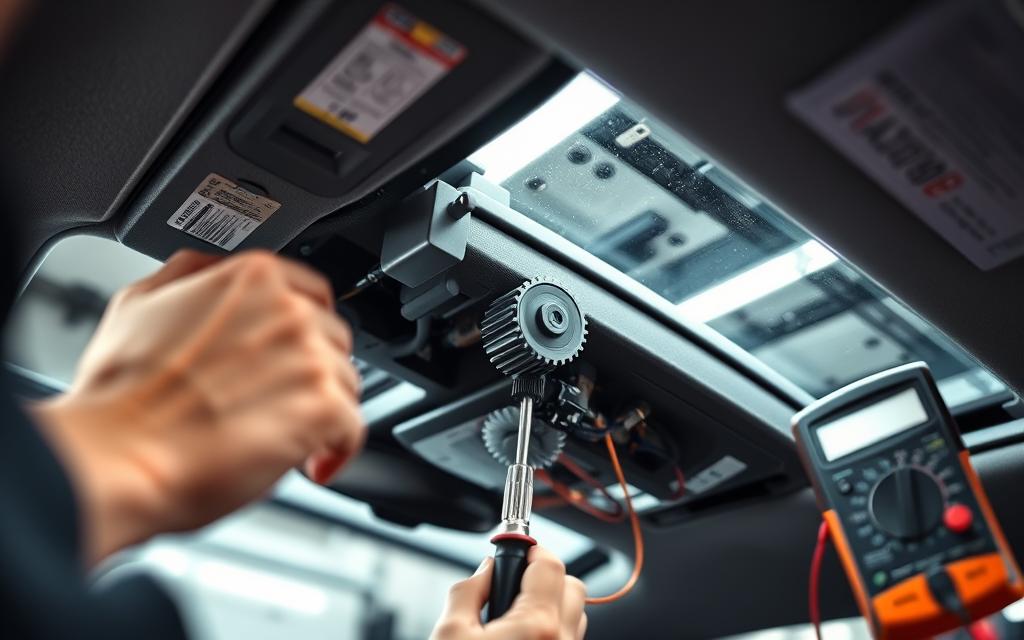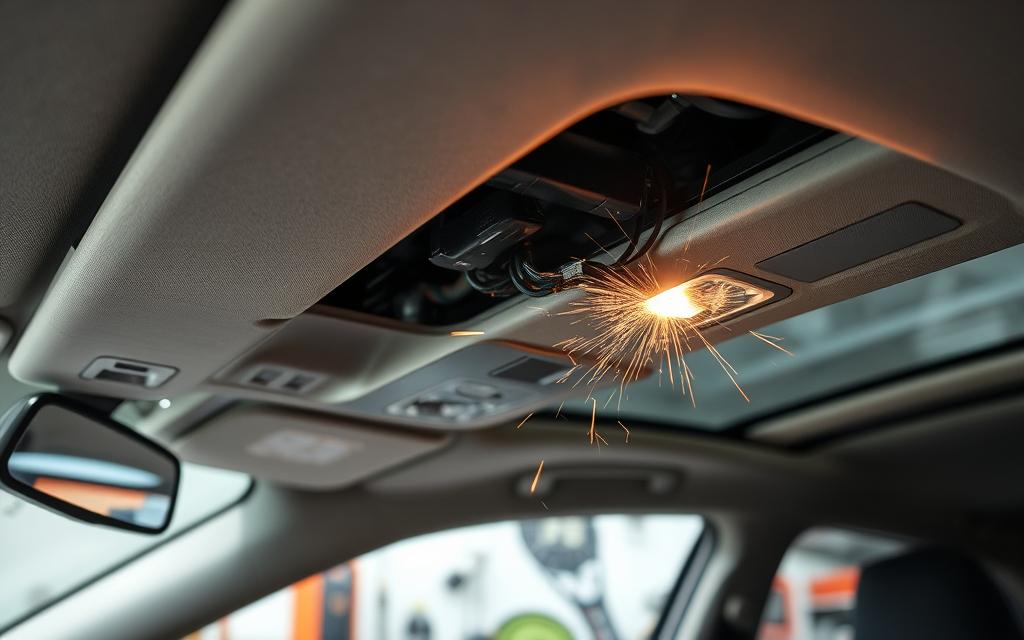If your sunroof won’t close fully, you’re not alone. Many car owners deal with this problem. It can cause water leaks and electrical issues. Knowing how to fix it is key to keeping your car in good shape.
In this guide, we share practical tips and ways to prevent problems. Whether it’s a small issue or a big one, our advice will help. Your sunroof will work well for years to come.
Key Takeaways
- Identifying common issues with sunroofs.
- Performing a visual inspection for obstructions.
- Checking electrical components, including fuses and motors.
- Regular maintenance to prevent future malfunctions.
- Steps to effectively reset your sunroof.
- When to consult a professional for repairs.
Understanding Sunroof Mechanism
The sunroof mechanism is key to enjoying your vehicle. Knowing how it works helps fix problems quickly. Each sunroof type offers a unique driving experience.
Types of Sunroofs
Sunroofs come in various designs, each with its own benefits and looks. Here are the most common types:
- Pop-Up Sunroofs: These can be tilted open, allowing for airflow without full exposure.
- Spoiler Sunroofs: Similar to pop-up models but designed to enhance aerodynamics.
- Panoramic Sunroofs: These extend across a significant portion of the roof, offering an expansive view.
Common Components of a Sunroof
Knowing the parts of a sunroof helps find and fix problems. The main components are:
| Component | Description |
|---|---|
| Glass Panel | The transparent part that allows light and air into the vehicle. |
| Motor | Powers the opening and closing actions of the sunroof. |
| Tracks | Guide the sunroof as it opens and closes, ensuring smooth operation. |
| Switch | Controls the functionality of the sunroof mechanism, located typically on the dashboard. |
Common Reasons for Sunroof Issues

A sunroof can make driving more enjoyable, but it can also have problems. Knowing the common issues helps find the main cause of the trouble. This part talks about key reasons for sunroof problems, like electrical issues, blockages, and lubrication problems.
Electrical Problems
Electrical issues with sunroofs often come from a dead motor, a bad switch, or battery or fuse problems. When these parts fail, the sunroof might get stuck. Tests can show if the motor needs to be replaced or if the wiring is the problem. Finding these issues early can help avoid expensive repairs later.
Obstructions in the Track
Blockages in the sunroof tracks are another big problem. Dirt and debris can get stuck, making the sunroof jam. If the guides get blocked, the sunroof might stay open. Keeping the tracks clean is key to avoiding these issues, as ignoring them can lead to bigger problems.
Lack of Lubrication
Not enough lubrication causes friction in the sunroof’s parts, leading to problems. Regular maintenance, like lubricating the tracks and cables, is important. Without enough lubrication, the sunroof won’t work right and could get damaged, costing a lot to fix.
Diagnosing the Problem

Figuring out sunroof problems can seem tough, but a clear plan makes it easier. First, do a visual check of the sunroof. Then, listen for odd sounds when it’s moving. These steps help spot issues quickly, making repairs faster.
Visual Inspection
Start by looking closely at the sunroof. Look for:
- Debris in the track that may block movement
- Cracks or damage on the sunroof glass
- Misalignment of the sunroof in its frame
These things affect how well the sunroof works. Spotting them early can prevent bigger problems.
Listening for Strange Noises
When you use the sunroof, listen for unusual sounds. Grinding, popping, or rattling noises mean something’s wrong. They could point to a problem with the motor, tracks, or other parts. Paying attention to these sounds is key to finding the issue.
Checking the Sunroof Switch

The sunroof switch is key to your car’s sunroof working right. It’s important to troubleshoot the sunroof switch well. Knowing how to test and clean the switch can avoid many problems.
Testing the Switch Functionality
First, check if the sunroof switch works. Here’s how to test it:
- Turn on the car and find the sunroof switch.
- Try to open the sunroof and see if it moves.
- If it doesn’t work, check the manual for electrical connections.
- Use a multimeter to check if the switch gets power.
Remember, a blown fuse might stop the switch from working. Always think of this when you’re fixing the sunroof switch.
Cleaning the Switch Area
Keep the sunroof switch area clean to make it work better. Cleaning it regularly can stop dirt and debris from causing problems. Here’s how to clean it:
- Use a soft cloth to wipe around the switch.
- For tough dirt, use a mild cleaner.
- Make sure no water gets into the switch’s electrical parts.
Cleaning the sunroof switch regularly can make it last longer and work better. Testing and cleaning the switch can solve problems early. This keeps your sunroof working well.
Inspecting the Sunroof Tracks

Keeping your sunroof working well means checking the tracks often. Cleaning and lubricating these parts helps them run smoothly. Here’s how to clean and oil your sunroof tracks right.
Cleaning Debris from Tracks
It’s key to keep the sunroof tracks clean to avoid problems. Start by:
- Opening the sunroof to get to the tracks.
- Using a soft brush or cloth to remove dirt and debris.
- Using a vacuum with a narrow nozzle to get rid of dust and small particles.
- Wiping the tracks with a damp cloth to remove any tough dirt.
Cleaning the tracks regularly helps prevent sticking or failure to close.
Lubrication Techniques
Using the right lubricant is crucial for your sunroof’s function. To lubricate effectively, do the following:
- Choose a good lubricant, like silicone spray or lithium grease.
- Apply the lubricant to the tracks after cleaning.
- Move the sunroof back and forth to spread the lubricant.
- Wipe off any extra lubricant from the edges.
Doing these maintenance steps keeps your sunroof running smoothly. It also lowers the risk of mechanical problems.
Resetting the Sunroof

Resetting the sunroof can solve many problems. It can fix issues like loud wind noise on the motorway. Here’s how to reset your sunroof.
Steps to Reset Most Sunroof Models
Follow these steps to reset your sunroof:
- Make sure the car is on and the key is in the ignition.
- Find the sunroof switch, which is usually a rocker design with a push button.
- Press and hold the switch in the up position for 20-40 seconds. This calibrates the system.
- If it doesn’t work, try disconnecting the car battery for a few minutes. This refreshes the system.
- After reconnecting, repeat the steps from step two.
- Try manually closing the sunroof if it’s stuck. This checks for motor or track problems.
Many people have fixed their sunroof issues with these steps. It recalibrates the Excessive Force Limitation (EFL) function. If problems continue, more detailed checks might be needed.
| Reset Step | Action | Outcome |
|---|---|---|
| Step 1 | Turn on the vehicle | Ensure power is available to the sunroof system |
| Step 2 | Press and hold the switch | Recalibrates the sunroof for normal functionality |
| Step 3 | Disconnect car battery | Refreshes the electronic control system |
| Step 4 | Manually close the sunroof | Helps identify any motor or track issues |
Resetting often fixes the sunroof’s functions, improving your experience. Paying close attention to the steps can solve common problems.
Dealing with Electrical Problems

Electrical issues are common with sunroofs. Catching these problems early can stop bigger issues. Key steps include checking fuses and testing the motor.
Checking the Fuses
Start by checking sunroof fuses. A blown fuse can stop the sunroof from working. Look for the fuse box under the dashboard or in the engine area. Your owner’s manual will show which fuse is for the sunroof.
Check the fuse for damage. If it’s blown, replace it with a fuse of the same rating.
Testing the Sunroof Motor
If fuses are okay, test the sunroof motor. The motor moves the sunroof panel and can wear out or have electrical problems. Try connecting a jumper wire to the motor to test it.
If it works with direct power, the issue might be with the wiring or switch. But if it doesn’t work, the motor might need to be replaced.
When to Seek Professional Help

Knowing when to get professional sunroof repair can save you time and money. There are clear signs that show you need an expert’s help, like when DIY fixes don’t work. Spotting these signs early can prevent bigger problems later.
Signs You Need a Mechanic
- Water Leaks: Leaks can harm your car’s electronics and cause mold, lowering its value.
- Shattered Sunroof: Even small cracks can get worse. Fixing them quickly stops the sunroof from breaking completely.
- Electrical Issues: A sunroof that won’t work might have a dead motor or blown fuse.
- Rattling Noises: Rattling sounds while driving could mean mechanical problems that need a pro to check.
- Cracked or Scratched Glass: Small damage can weaken the sunroof. Fixing it fast can stop bigger problems.
- Mechanical Failures: Trouble with moving parts or opening and closing means you need a mechanic’s help.
Cost Considerations
Knowing what sunroof repairs cost can help you make better choices. Prices vary based on several things:
| Type of Repair | Estimated Cost (USD) |
|---|---|
| Basic Seal Replacement | $150 – $300 |
| Glass Replacement | $400 – $1000 |
| Electrical Diagnosis | $100 – $200 |
| Mechanical Repairs | $200 – $500 |
Preventative Maintenance for Sunroofs

Regular maintenance is key to keeping your sunroof in top shape. It helps prevent problems and makes driving more enjoyable. By following cleaning tips, you can avoid mechanical issues later on.
Regular Cleaning Tips
It’s important to keep the sunroof clean, even more so before winter. Debris and dirt can block the drains, causing problems. Here are some cleaning tips:
- Clear the sunroof drains regularly to prevent clogging.
- Use a soft brush to remove any debris from the sunroof edges.
- Power wash the car before winter to eliminate buildup around the sunroof area.
- Inspect and clean the rubber seals to maintain proper sealing against water and air leaks.
Recommended Lubricants
Choosing the right lubricants is vital for sunroof care. Special products prevent rust and keep parts moving smoothly. Here are some suggestions:
- White lithium grease is ideal for periodic maintenance, ensuring smooth operation of the sliding mechanism.
- Use silicone spray for rubber seals to protect against harsh winter conditions.
- Consider specialized sealants designed for sunroofs, which provide additional protection from moisture and freezing.
By taking these steps, you can avoid many sunroof problems, even in harsh winter. Being proactive helps keep your sunroof working well and leak-free.
Conclusion and Final Thoughts
Understanding the importance of sunroof repair is crucial for keeping your car in top shape. Fixing issues quickly can stop bigger problems and save you money. It’s important to notice signs like trouble opening, strange noises, or leaks early on.
Importance of Timely Repairs
Waiting too long to fix your sunroof can cause more harm. Issues like misalignment or blockages need quick action. Regular checks and fast responses to problems are key to keeping your sunroof working well.
Encouragement to Maintain Sunroof Functionality
To prevent sunroof problems, follow a regular maintenance plan. Clean and lubricate your sunroof often, and fix any odd behavior right away. This will make your sunroof last longer and improve your driving experience.
FAQ
How can I fix a sunroof that won’t close all the way?
What types of sunroofs are there?
What are the common signs of electrical problems with a sunroof?
How do I clean and maintain sunroof tracks?
When should I consider professional help for my sunroof?
What can I do to prevent sunroof leaks?
How do I reset my sunroof?
Why is sunroof lubrication important?

Jack Thompson is a writer and seasoned auto mechanic with over 15 years of experience in the automotive industry. Known for his expertise in vehicle mechanics, Jack has a deep understanding of car and truck systems. His skills, honed through years of hands-on experience, have made him a trusted name in the field. Jack is committed to providing valuable insights into car maintenance and repair, helping vehicle owners keep their vehicles in top condition.

